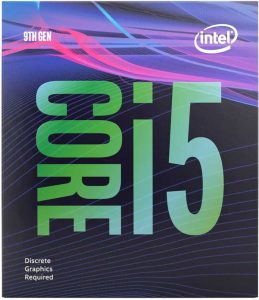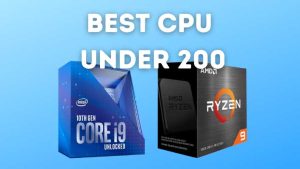Here you will find the best selection of high-performance CPUs for an affordable price, whether you are building a PC from scratch, or replacing parts in an existing one.
In this article, we will discuss a few of the best CPUs under $300 in 2023, as well as their pros and cons. You will find this information extremely helpful if you are looking for a pro processor entry-level.
My other articles on my site, such as Best CPUs Under $200, will help you find a cheaper option.
Top Best CPUs Under 300$ in 2023
AMD Ryzen 7 3700X Unlocked Desktop Processor
Ryzen 7 3700X processors have eight cores and sixteen threads, and clock speeds of up to 4.4 GHz. A total of 128GB of DDR4 RAM is supported out of the box. As a part of the 3rd generation of Ryzen processors, it utilizes the 7 nanometers Zen 2 architecture.
This processor will outperform others on this list when it comes to multitasking when compared to others.
We have taken a closer look at 32-core benchmarks for the 3700X in order to see where it truly excels. Octa-core speed no longer makes sense in many benchmarks; we prefer to use 64-core benchmarks instead.
When it comes to single-core performance, the 3700X scores 135 points higher than the i7-9700F based on average user benchmarks.
You can find the 3700X at 1,408 points when reviewing the 64-Core speed scores. On heavy multithreaded workloads, this is almost 50% faster than an 8-core processor such as the i7-9700F.
This is the least expensive CPU for professional content creators or artists to be able to deal with the multi-threaded abuse that you will inevitably put it through.
Despite being a multitasking machine in the under $300 price range, the 3700X’s single-core performance is better than you would expect for the price. In this configuration, you can use it as a productivity machine or as a gaming machine.
Gaming and streaming can both be done simultaneously with this processor without missing a beat.
As part of AMD’s Gen 3 architecture, it supports PCIe 4.0. For those who are unfamiliar with it, PCIe 4.0 transports data between your PC components and the CPU. Due to PCIe 4.0’s twice data transfer rate, Zen 2 processors offer a significant performance advantage over other processors on the market today.
Part manufacturers have yet to build PCIe 4.0-compliant parts, so this is more of a future-proofing concern. In many production setups using multiple GPUs, PCIe 3.0 may reach its limits with the advent of graphics cards that could debut this year.
In the current market, the highest-performing graphics cards consume too much bandwidth when connected to an 8x PCIe 3.0. The move toward PCIe 4.0 is likely to be a big change in the coming months.
Under $300, you can’t go wrong with AMD Ryzen 7 3700X.
AMD Ryzen 7 2700X Processor
Featuring 16 threads and 8 cores, the Ryzen 7 2700X clocks in at 3.7 GHz and 4.3 GHz. This is the predecessor to the Ryzen 7 3700X, which replaced the 2700X.
Powered by the Zen+ architecture, the 2700X can only handle PCIe 3.0. The 2700X achieved 118 points on a single-core basis based on its average user benchmark score, but it performed well on 64 cores at 1259 points based on the same average benchmark score.
There are no plans to introduce another Zen+ processor. Instead, AMD is focusing on promoting the 400 series chipsets, like the B450 and X470. The motherboard chipset is not as challenging for AMD products as it would be for Intel products because AMD backward compatibility is a norm for most Ryzen products.
When a processor is matched with a motherboard that is up-to-date, more features can be accessed. It may not be possible to take advantage of all the new benefits when you use backward compatible motherboards and newer processors, but you’re still able to use it, unlike Intel changing model numbers each year.
Thanks to its high core count and multi-threading capabilities, this PC is able to handle nearly anything you throw at it. Heavy workloads from content creators will certainly not be a problem.
For professionals, I recommend the 3700X over the 2700X only because the cost of upgrading is minimal. The wraith cooler that comes with the 2700X can be added for additional cooling if you plan to overclock it at its maximum levels.
Intel Core i5-11400F Desktop Processor
The budget range typically has a number of great choices for gaming processors. When it comes to value gaming, Intel Core i5 and AMD Ryzen 5 non-X processors are usually the best choices. Because of widespread global supply chain problems, the price of processors has increased (as has the price of all PC hardware).
Although we used to give the “value” award to Ryzen 5 CPUs in the past, as of now, the i5-11400F takes the prize due to its fairly affordable price.
AMD’s Ryzen 5 5600X is nearly $100 cheaper than the i5-11400F at just over $200. However, the 5600X probably performs better than the i5-11400F in general. Although the single-core performance of the i5-11400F is excellent, it will perform similarly (or even better) for pure gaming.
Though the i5-11400F isn’t the best processor, it cannot be overclocked since it is a locked CPU. In any case, for only a little over $200, it will provide excellent performance in-game assuming you have a graphics card that matches the resolution you are using (and, of course, finding a suitable graphics card at the moment is a whole other matter).
In general, the i5-11400F is probably the best mid-range CPU that is currently available for an affordable price. It makes sense for those looking for excellent gaming performance at a reasonable price.
AMD Ryzen 5 3600 Unlocked Processor
AMD Ryzen 5 3600 has a low price and a quick gaming experience to make your gaming more enjoyable. Despite not being the most current version, it is still of value. Since it is cheaper and its functionality is almost the same, it can present a challenge to its update.
In the segment of PC gaming, it includes a processor that is among the most advanced. The latest processors ensure faster operation, regardless of whether the game or other program is heavy.
There are some games that run extremely fast in the world. With its ultra-fast speed, it can provide you with speeds of up to 100 frames per second.
The processor has 12 threads but multiple cores. The cooling system, AMD wrath cooler max, prevents it from overheating.
It has four 2 GHz cores with unlocked boosts, which allows it to overclock 35 MBS of game cache. A 4 0 socket is also available on motherboards supporting x570.
Especially if you’re looking for a CPU for VR that’s low in price and capable of working smoothly with a high speed, then this can be your best choice. The CPU listed here is one of the best CPUs for VR, though it may not be the most advanced version.
AMD Ryzen 5 3600XT Desktop Processor
There are six cores and twelve threads in AMD Ryzen 5 3600XT. Turbo boost clock speeds are as high as 4.5 MHz. Base clock speeds are 3.8 MHz.
Ryzen XT processors are based on an updated Zen 2 architecture. In this case, it’s not a completely new architecture or build than for instance the 3700X, but rather a more optimized version of the same processor.
Performance improvements over the 3600X of 2-4% were possible with the higher frequency. As one of the fastest single-core processors under $300, the CPU averages 141 points for the single-core benchmark.
This may be important to you if you are a gamer or overclocker driven by a tight budget. Consider the 3600X if you need a 6-core processor but are more price-conscious.
Its lack of built-in graphics means that it is dependent on a discrete graphics card, as with most high-end processors. In line with previous Ryzen products, this is built for the AM4 socket with PCIe generation 4.0, but you will need a motherboard from the 570 or 550 series to take advantage of it. The processor supports 128 GB of DDR4 memory at 3200 MHz out of the box.
This is not a processor for the average everyday consumer or even for professional PC users. The principal purpose of buying this processor is to achieve extreme benchmarks without breaking the bank.
AMD Ryzen 5 2600X Processor
For VR, AMD Ryzen 5 2500x is the best CPU option if you want it to work smoothly and not overheat.
With the latest coolers installed, heat dissipation is reduced to a greater degree. This version has updated the AMD Wraith spire coolers and they have been moved to the top. The cooler will not be noticeable, and the silent machine will not contribute to the noise pollution issue.
The 19 MBS cache makes it a good choice for gamers who expect a fast gaming experience. A device’s cache controls the execution of its programs.
There are motherboards that can’t fit every CPU, so if you already have a motherboard, make sure it fits the CPU. AM4 socket motherboards are needed for this. You should not purchase this device if your motherboard is not compatible, and if you already own this or want to purchase it, you should search for a motherboard that is compatible.
AMD Rizen VR-ready premium technology, AMD store technology, and sensing technology are some of the technologies supported by it. Despite this, you must make some compromises in order to make it special.
These features can draw you to buy this device, including a lower price, sound cooling system, and a faster experience. At this price, you will not regret your purchase.
Intel Core i5-9400F Desktop Processor
Buying an expensive and high-profile CPU will only add to the cost of video editing if you are just getting started. Beginners should look for a CPU that fits comfortably in their budget. However, despite being one of the most economically priced CPUs on our list, it does not compromise on quality. The Intel processor in particular is an excellent processor for video editing.
The CPU can handle video editing and rendering pretty well since it has six cores and twelve threads. It has intel optane memory, which facilitates heavy workloads as well as being part of the 9th generation of Intel processors.
CPU clock speed is 4.1 GHz, and cache speed is 9 MB, which means that video editing at beginner to pro levels will be no problem.
CPU is highly efficient, with a TDP of 65W, so it won’t heat up when working, so you wouldn’t need to use a cooler with this CPU.
Despite its high efficiency and low cost, this CPU comes with a few downsides. First of all, it works best on single-core machines, but on multiple-core machines, it is not as good. Additionally, it does not include integrated graphics.
GPUs do not affect video editing quality, but they do affect the installation and operation of some video editing programs. It is compatible only with Intel 300 series chipsets, as are all Intel CPUs.
Commonly asked questions
How do I choose a CPU?
Choosing a CPU can be a complex decision, and it depends on your specific needs and budget. Here are some factors to consider when choosing a CPU:
- Processor architecture: The two main architectures currently available are Intel and AMD. Intel processors are generally considered to be better for gaming and video editing, while AMD processors are generally considered to be better for multitasking and content creation.
- Core count and thread count: More cores and threads generally mean better multitasking performance and faster rendering of videos and images.
- Clock speed: This is measured in GHz and it represents the processor’s speed. A higher clock speed generally means better performance, but it also consumes more power and generates more heat.
- TDP: TDP stands for Thermal Design Power, it’s a measure of the amount of heat a CPU generates and it’s an indicator of how much power a CPU consumes. A CPU with a lower TDP will consume less power and generate less heat.
- Compatibility: Make sure the CPU is compatible with your motherboard and cooling system.
- Price: CPUs range from budget-friendly options to high-end, expensive options. It’s important to set a budget and find the best CPU that fits your needs within your budget.
- Future-proofing: Consider the CPU’s ability to handle future software and technology advancements.
It’s recommended to research the different CPUs available on the market, read reviews, and compare the features and specifications of each CPU. It’s also important to take into account the intended use of your computer, whether it’s for gaming, content creation, or general-purpose use.
Which are the most common types of computer CPUs?
The most common types of computer CPUs are Intel-compatible x86 and ARM.
Intel-compatible x86 CPUs are used in most personal computers and servers, and are compatible with the instruction set developed by Intel. These CPUs are known for their high performance and are used in a wide range of applications, from desktop PCs and laptops to servers and workstations.
ARM CPUs are used in mobile devices, embedded systems, and some low-power servers. They are known for their low power consumption and high efficiency, making them well-suited for battery-powered devices like smartphones, tablets, and IoT devices. ARM processors are also widely used in embedded systems and other small form-factor applications.
RISC-V is becoming increasingly popular in embedded systems, IoT devices, and other low-power, small form-factor applications, but it is not as widely used as the other two types.
What determines how good a CPU is?
A CPU’s performance is determined by several factors, including:
- Core count and thread count: More cores and threads generally mean better multitasking performance and faster rendering of videos and images.
- Clock speed: This is measured in GHz and it represents the processor’s speed. A higher clock speed generally means better performance, but it also consumes more power and generates more heat.
- Instructions per cycle (IPC): This is a measure of how efficiently a CPU can execute instructions and it is an indicator of the performance of the CPU. A higher IPC generally means better performance.
- Architecture: The architecture of the CPU can also play a role in performance. Some architectures are more efficient than others and can handle more complex instructions.
- Cache: Larger cache sizes generally mean better performance as it allows the CPU to quickly access frequently used data.
- Power consumption: A CPU with a lower TDP (Thermal Design Power) will consume less power and generate less heat, which can result in better performance.
- Compatibility: Make sure the CPU is compatible with your motherboard and cooling system.
- Price: The price of the CPU can also be a factor, as more expensive CPUs tend to have better performance.
How much should a budget CPU cost?
The cost of a budget CPU can vary depending on the specific model and its capabilities. Generally, a budget CPU can cost anywhere from around $50 to $200. It is important to consider the specific needs and usage of the CPU when determining a budget. A budget CPU will not be as powerful as a high-end CPU, but it should still be able to handle basic tasks such as web browsing, word processing, and video playback.
Conclusion
From this list of CPUs, you can select the right one by using these tips. If you are wondering which one you should select, then here are some quick suggestions. Establish your budget before proceeding. If you know that you won’t use your CPU to its full capacity, don’t spend too much on it.
You can also build the best gaming rig for you, even if you’re just building it for casual gaming, with a 6-core CPU. You’ll enjoy the best gaming experience with a gentle impact on your budget. You should choose one of the 8 Core CPUs listed above if you are a gamer and a content creator.











